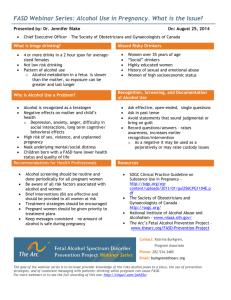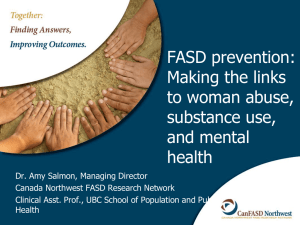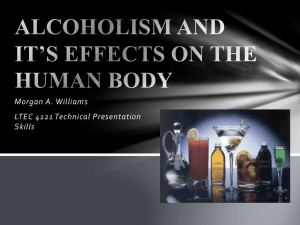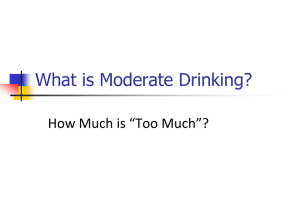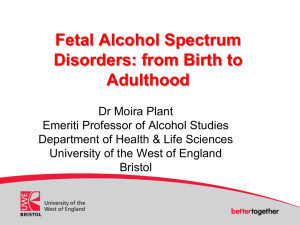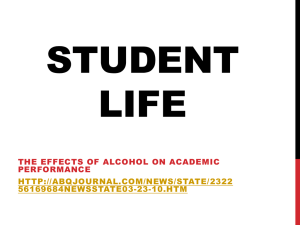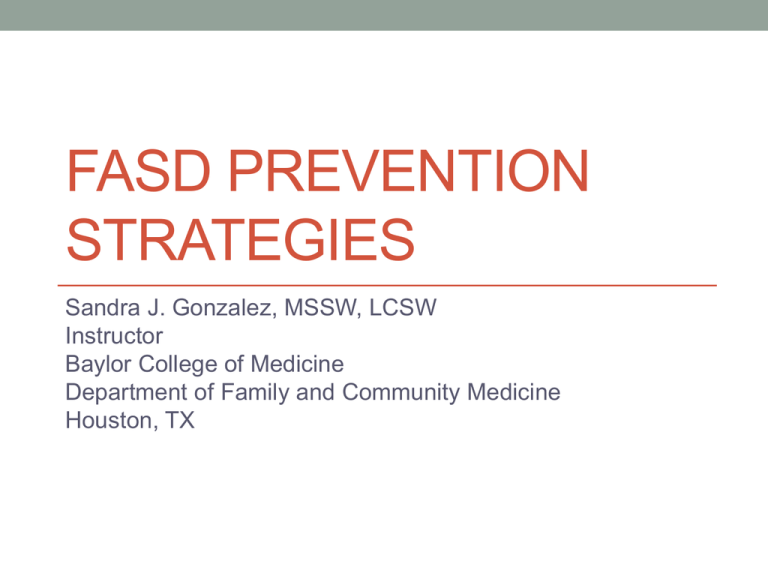
FASD PREVENTION
STRATEGIES
Sandra J. Gonzalez, MSSW, LCSW
Instructor
Baylor College of Medicine
Department of Family and Community Medicine
Houston, TX
2
Amount of Alcohol
• Follow-up study.
• Neuropsychological testing in four Danish
cities 2003– 2008. IQ, attention and
Executive Function
• A cohort of 1628 women and their children
5 years of age
• BJOG 2012;119:1180–1190.
3
Amount of Alcohol
• No significant association of low to moderate
average weekly alcohol consumption (1-4;58/wk), and any binge drinking, during early to mid
pregnancy with the neurodevelopment of children
at the age of 5 years.
• High levels of alcohol (> 9 or more drinks per
week), was associated with lower attention span
amongst five year olds.
• BJOG 2012;119:1180–1190.
4
Researchers’ Discussion
• “To
date, the scientific literature, including
the present study, does not establish a safe
level of alcohol consumption during
pregnancy.”
• As alcohol is a known teratogen, it remains
the most conservative advice for women to
abstain from alcohol during pregnancy.”
• BJOG 2012;119:1180–1190.
5
No known safe amount of
alcohol to drink while pregnant
Brain
Nerves
Brain
Stomach
Placenta
Fetus
Breast
Heart
Organs
Liver
Muscles
Kidneys
6
Alcohol and Pregnancy
• Alcohol is a teratogen
• Drinking during pregnancy can lead to
sudden infant death syndrome and fetal
alcohol spectrum disorders.
• ACOG. Committee Opinion. Number 496. August 2011
• CDC
7
Major Effects of Ethanol by Trimester of
Pregnancy
The most prudent advice you can give to all women is to stop
drinking before conception and to maintain abstinence through-out
pregnancy and during breast feeding.
(UCLA RTC)
8
Alcohol and Breastfeeding
• There is reduced milk consumption by
infants of lactating women consuming
alcohol.
• Associated with altered postnatal growth,
sleep pattern, and psychomotor patterns.
• After breastfeeding is established, mothers
should wait 3-4 hours after a single drink
before breastfeeding
• ACOG. Committee Opinion. Number 496. August 2011
The problem: Risky drinking
• More than 80,000 people in the U.S. die each year due to
alcohol-related causes
• Third leading cause of death.
• In 2006, cost out numbered tobacco and obesity resulting
in $223.5 billion in lost productivity, health care, criminal
justice, motor vehicle crashes, fetal alcohol syndrome,
and fire and property damage (Bouchery et al., 2011).
• There is no known safe level of drinking and alcohol
causes 10 times as many deaths as it prevents (American
Journal of Public Health, 2013).
The Health and Social Effects of Risky
Drinking
Immediate Effects
Long-Term Effects
Motor vehicle
crashes
Assaults and
sexual assaults
Gastritis
Liver cirrhosis
Pedestrian
injuries
Child abuse and
neglect
Hypertension
Cancer
Drowning
Property crimes
Cardiovascular
disease
Pancreatitis
Unintended sex
and pregnancy
Homicide
Fetal alcohol
spectrum
disorders
Diabetes
Alcohol
poisoning
Suicide
Stroke
Neurologic
disorders
The response: Screening and brief
intervention
• Purpose of SBI:
• Intended to meet public health goal of reducing harms and societal
costs associated with risky drinking
• Use a system’s approach to:
• Incorporate alcohol SBI into day-to-day clinical
practice
• Identify barriers and facilitators to
implementation
• Identify methods to overcome barriers and
create solutions
• Evaluate the uptake of alcohol SBI in the clinics
Rationale
• Target for brief interventions is non-dependent risky
•
•
•
•
drinker.
Should also screen, motivate, and refer those who are
alcohol dependent.
Previous research demonstrates that brief intervention is
effective in primary care practices.
The overall program is cost-effective and beneficial.
Effective although simple and brief.
The Effect of Marketing
What is a standard drink?
Risky Drinking Levels for Healthy Adults
Healthy men ages 21-65
No more than 4 drinks on any single
day
(*5 or more drinks consumed within
2 hours is binge drinking)
No more than 14 drinks a week
All healthy women ages 21 and
older
Healthy men over age 65
No more than 3 drinks on any single
day (*4 or more drinks consumed
within 2 hours is binge drinking)
No more than 7 drinks a week
Adapted from: Planning and Implementing Screening and
Brief Intervention for Risky Alcohol Use: A Step by Step
Guide for Primary Care Practices. Available at:
http://www.cdc.gov/ncbddd/fasd/alcohol-screening.html
Other considerations
• Those taking prescription or OTC medications that may
interact with alcohol, causing harmful reactions.
• Those with medical conditions that may be worsened by
alcohol (liver disease, pancreatitis).
• Those who are driving, planning to drive, or participating
in other activities requiring skill, coordination, and
alertness.
• Those where any drinking at all is considered risky:
• Unable to control the amount they drink, including those who are
dependent.
• Women who are pregnant or might become pregnant.
• Under the age of 21.
Screening Instruments
• *Single question alcohol screen – “How many times in the
•
•
•
•
•
•
past year have you had X (5 for men; 4 for women) or
more drinks in a day?
*AUDIT 1-3 (US)
AUDIT (US)
CAGE – Primary care
RAPS4 – Emergency department
T-ACE – Ob/Gyn, primary care
TWEAK – Ob/Gyn, primary care, emergency department
The Alcohol Use Disorders Identification
Test (AUDIT)
Protocol using AUDIT 1-3 (US) and
AUDIT (US)
If using
AUDIT 1-3
(US), Zone 1
is negative
Brochure
Brochure
Sample Brief Intervention Protocol
Raise subject: “If it’s okay with you, let’s talk about the
health and wellness form you filled out today”
Provide feedback: “I am concerned about how your
drinking may affect your health and possibly the health
problem you came in for today.” “It is recommended that you
consume no more than 3 drinks per day for women (7 per
week) and 4 per day for men (14 per week).”
Assess readiness to change (show the scale): “On a
scale of 0-10, how ready are you to cut back your use?”
Enter Number Chosen
1)
2)
3)
a.
b.
If >0: Proceed to plan
If 0: Select Unwilling: “What would have to happen for you to
consider cutting back?” *If patient is unwilling BI will end here.
Sample brief intervention protocol
Negotiate a plan:
4)
“Let’s set a drinking goal, what do you think will work best
for you?” (Try to make it within limits but keep it realistic)
a.
i.
ii.
Enter goal: # drinks per week and per day
Write down goal on handout and give to patient
“Can you think of anything that might get in the way of
achieving your goal?”
b.
i.
Write down barriers in EMR and on handout
Set up a follow up appointment 4-6 weeks out
5)
a.
At follow up reassess goal and if patient needs further
assistance
24
SAMHSA 2010 National Survey on
Drug use and Health
• 57% women of childbearing age (15-44) currently drink
• Among pregnant women (15-44)
• 9.4 percent reported current alcohol use
• 2.6 percent reported binge drinking
• 0.4 percent reported heavy drinking
Substance Abuse and Mental Health Services Administration, Results from the 2010 National Survey on
Drug Use and Health: Summary of National Findings, NSDUH Series H-41, HHS Publication No. (SMA) 114658. Rockville, MD: Substance Abuse and Mental Health Services Administration, 2011.
25
26
Start with the Basics!
• Decrease unintended pregnancies
• Initiate contraceptive efforts
• Confirm proper and
consistent use
Example from Project CHOICES
Changing High-Risk AlcOhol Use &
Increasing Contraception Effectiveness Study
Photo: courtesy Dang, CDC
.
27
Project CHOICES
• 4 motivational counseling sessions and a
contraception consultation visit delivered
over 12-14 weeks
• At 3, 6, and 9 month follow-up, the odds for
reducing the risk of an Alcohol Exposed
Pregnancy (AEP) were 2-fold higher among
women receiving the intervention as compared
to the control group.
Floyd, et al. Preventing Alcohol-Exposed Pregnancies: A Randomized Controlled Trial
American Journal of Preventive Medicine; January 2007; 32(1):1-10.
28
Father’s Effect
• To date, there is no physical link between a
father’s drinking and FASDs.
• However, a mother’s drinking behavior can
be influenced by the drinking behaviors of
those around her, including her partner.
• http://www.usd.edu/medical-school/center-for-disabilities/upload/fasdhandbook.pdf
29
Alcohol Assessment:
Frequency and Quantity
First ask: Do you drink alcohol, including beer,
wine or distilled spirits?
• On average, how many days per week do you
drink alcohol?
• On a typical day when you drink, how many
drinks do you have?
• What’s the maximum number of drinks you
had on a given occasion in the last month?
30
How Much Do You Drink? Most
Doctors Never Ask
• A survey in 2011 of 166,753 adults (>18) from 44
states and DC found:
• One in six adults said a health professional has
ever discussed drinking with them.
• Just 17% of pregnant women at the time of
survey said they had ever been asked about
drinking.
• USA Today. January 7, 2014
31
Barriers We Face as Providers
Prevention of Alcohol Use among Pregnant
Women
Lack of training
Uncertain about how to intervene if
problem is found
Time constraints
Personal discomfort
Weisner C, Matzger H. Alcohol Clin Exp Res. 2003 Jul;27(7):1132-41;
Nevin AC et al. BMC Fam Pract. 2002;3:2.
Zoorob R, Aliyu MH, Hayes C. Alcohol. 2010 Jun;44(4):379-85.
32
It may be difficult to talk with patients
about
alcohol use and the prevention of
FASDs, but
you can do it
and there are resources that can
help!
33
“Keep It Simple”
• FASDs are 100% preventable
• there is no known safe amount of alcohol to
drink while pregnant
• there is no safe time during pregnancy to
drink
• there is no safe type of alcohol
“Practice Makes Perfect”
for providers regarding screening and
prevention
34
• “We must prevent all injury and illness that is
preventable in society, and alcohol-related birth defects
are completely preventable…”
• “When a pregnant woman drinks alcohol, so does her
baby. Therefore, it's in the child's best interest for a
pregnant woman to simply not drink alcohol."
Vice Adm. Richard Carmona,
U.S. Surgeon General 2002-2006
35
In Summary
• Asses alcohol intake in pregnant and women in the child
bearing age
• Use brief intervention techniques to help pregnant women
who consume alcohol
• FASDs are 100% preventable—if a woman does not drink
alcohol while she is pregnant
• Early Recognition and multidisciplinary intervention of
FASDs will decrease the impact
36
THE END
37
Information and Treatment Resources
Southeast Fetal Alcohol Spectrum Disorders
Regional Training Center
Meharry Medical College Dept. of Family Medicine –
Nashville, TN
Tel: (615) 327-5525
University of Louisville Weisskopf Child Evaluation Center -
Louisville, KY
Tel: (502) 852-3020
http://www.fasdsoutheast.org
38
Information and Treatment Resources
• The Arc of the United States
• The Arc of South Carolina - Tel (803) 748-5020
• www.arcsc.org
• The Arc of Coastal Carolina - Tel (803) 238-3040
• The Arc of Pickens – Tel (864) 859-5416
• NOFAS (National Organization on FAS)
Phone: 202-785-4585 Web: www.nofas.org
• Local Alcohol and Drug Treatment Resources:
http://findtreatment.samhsa.gov/facilitylocatordoc.htm
Tools from www.cdc.gov/fasd
Elizabeth P. Dang, MPH, Behavioral Scientist, FAS Prevention Team, National Center on Birth
Defects and Developmental Disabilities, Centers for Disease Control and Prevention
40
FASD Prevention Tool Kit
• Developed by ACOG and CDC
• Contains
• Brief guide
• Laminated screening
instrument
• Resource information
• Patient handouts
• CME credits available
41
Information and Treatment
Resources
• National Organization on FAS (NOFAS)
(202) 785-4585 www.nofas.org
• Local Alcohol and Drug Treatment Resources
http://findtreatment.samhsa.gov/facilitylocatordoc.htm
• CDC FASD Home Page www.cdc.gov/fasd
• Southeast Fetal Alcohol Spectrum Disorder Regional Training
Center
(FASD RTC) in the Meharry Medical College Department of
Family & Community Medicine
615) 327-5525
www.familymedicine.mmc.edu
www.fasdsoutheast.org
42
FASD Regional Training Centers
2011-2014
Washington
Montana
Vermont
Minnesota
North Dakota
Maine
Michigan
Oregon
New
Hampshire
Wisconsin
Massachusetts
South Dakota
Idaho
New York
Wyoming
Michigan
Rhode Island
Pennsylvania
Iowa
Nebraska
New Jersey
Nevada
Indiana
Ohio
DC
Delaware
Illinois
Utah
West
Virginia
Colorado
California
Kansas
Missouri
Maryland
Virginia
Kentucky
North Carolina
Tennessee
Arizona
Oklahoma
Arkansas
South
Carolina
New Mexico
Mississippi
Georgia
Alabama
Texas
Louisiana
Alaska
Hawaii
Connecticut
Florida
Arctic RTC, Univ of Alaska Anchorage
Midwestern RTC, Saint Louis Univ
Great Lakes RTC, Univ of Wisconsin
Southeastern RTC, Meharry Medical College
Frontier RTC, Univ of Nevada Reno

